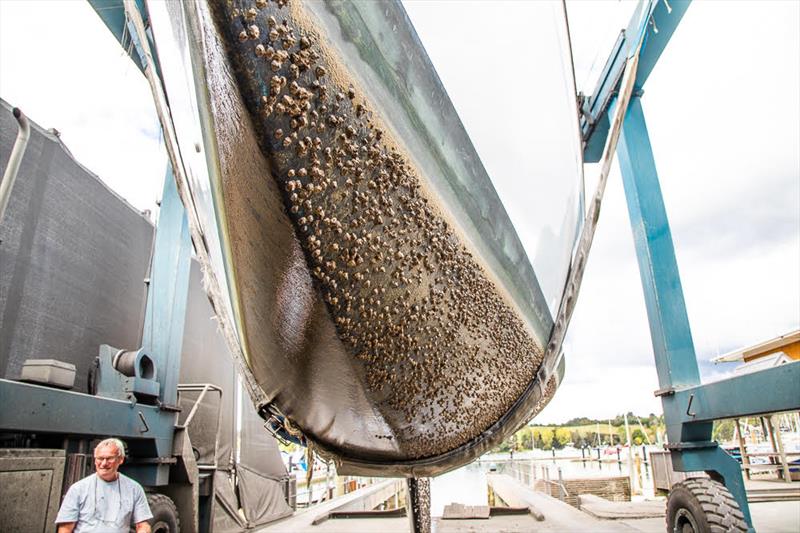
Marine Biosecurity: Antifouling coatings -The performance cost of a dirty hull - Part 3
by Clean Below? Good to Go 29 Oct 2021 20:24 NZDT
13 October 2021

This vessel was treated with two types of antifoul as an experiment. Barnacle encrustation has a negative impact on the efficiency of the hull moving through the water through the increase in drag. This reduces speed and increases fuel consumption © Kevin Purdy
A clean hull benefits a boat’s performance – and a dirty hull reduces it. But exactly how much so?
“Ask any racing yachtsperson if their boat is slower when fouled, even with a bit of slime,” says antifoul coating specialist Kevin Purdy. “The answer will be an emphatic yes.”
The U.S. Navy estimates that heavy barnacle growth on ships increases weight and drag by as much as 60 percent, resulting in as much as a 40 percent increase in fuel consumption.
While battleships and cruise ships are a very different beast, they provide an indication of the impact that biofouling can have even on an average family cruiser.
“Boat on boat comparisons are difficult to come by because true testing is nearly impossible to conduct in a controlled environment,” says yacht designer Kevin Dibley. “Any small change in waves, wind or height will have an affect on boat speed.” CHECK QUOTE.
However boatyard operators - like The Landing Hardstand in Okahu Bay, Auckland say customers report getting a speed increase of 1-2 knots after a good clean.
We also asked users of the local sailing forum Crew.org.nz about their experiences. Some of the responses are testament to a significant difference:
• At 2500 rpm I would do 5kts dirty and 6kts clean.
• 18kts clean and down to 14kts dirty at the same RPM
• We hauled last month. 5.2 going to Gulf Harbour, 6.4 or thereabouts coming home. No heavy growth, just a waterblast and a polish of the coppercoat.
• Measured before and after a full scrape and anti-foul: Engine struggled to get the yacht up to 5.5kt at around 2,800rpm. Now it does 6kt @ 2,000rpm. Hull not heavily fouled.
• 5.6Knts @ 2800 dirty; 6Knts clean @2800 straight out of strops.
Doug Dukeson is a publisher of Pacific PowerBoat magazine who has written extensively about antifouling coatings and also a co-director of Hibiscus Marine Coatings.
“There are all sorts of technical formulas used to calculate the efficiency loss, due to hull and propeller fouling,” he explains. “At Hibiscus Marine Coatings, we gauge this through our own experience and from our clients comments and feedback, and some claim to loose several knots off their normal speed.”
Doug explains that a boat that is fouled will be slower at its traditional cruising RPM. This is because it is running less efficiently due to the extra drag created by the growth.
“This equates in more fuel to get the same speed and destination. For competitive racing sailors, these loss of a few knots could mean a win or loss of a race.”
“Keeping up with a regular antifoul programme is in fact potentially going to, in the long term, save powerboaties money while cruising and help keep sailors competitive in the race series,” he says.
Antifoul tips for boat owners
Choosing the right antifouling coating for your boat depends on a large number of factors including how you use the boat and where it is moored, says Brent Wilson of Marsden Cove Marina. He says it’s important to talk to specialists about what you need because a product that works well on a boat in one location may not work well on the same boat in a different part of the coast.
He recommends talking to specialist paint stores over chandleries because they have the expertise about their product ranges and are in the best position to give you the best advice. He also recommends getting personal advice by chatting with other boat owners in your vicinity about what is working well for them. Once you’ve made a decision, make sure you follow the manufacturer’s instructions.
Brent says preparation is always key and while it’s an unpleasant chore, removing the old antifoul completely is necessary to get long life from your new coat. And if the product recommended by a specialist doesn’t work and growth appears quickly, you are likely to have comeback under consumer protection laws too.
If you are doing your own antifoul preparation or application, please be aware of safety requirements. Please follow Environmental Protection Authority guidelines which you can find here.
This is Part 3 in our special antifoul series. The information expressed in this article is the opinion of those interviewed and not necessarily that of ‘Clean Below? Good to Go’. Please seek expert advice when choosing and applying an antifoul coating.
Get info and advice about marine biosecurity for boaties at www.marinepests.nz